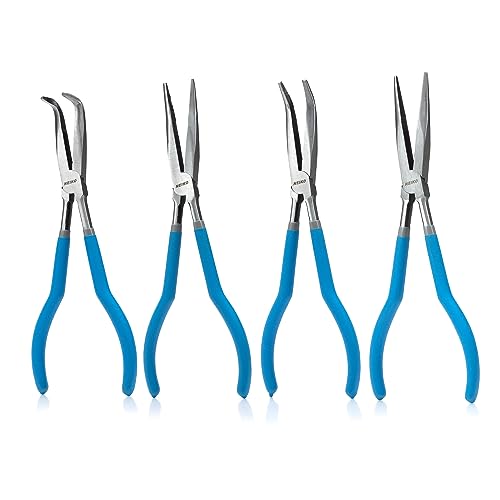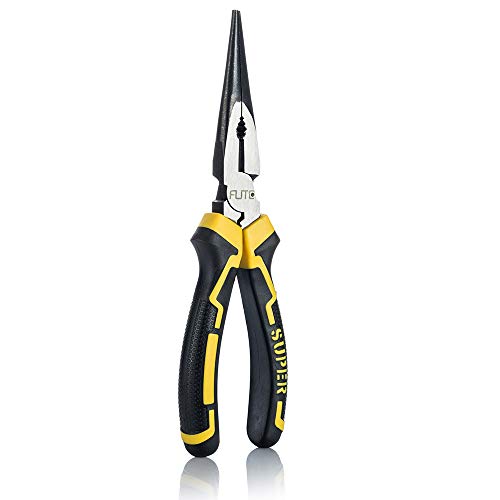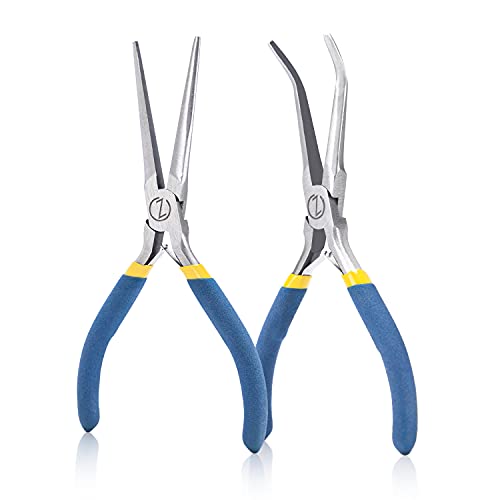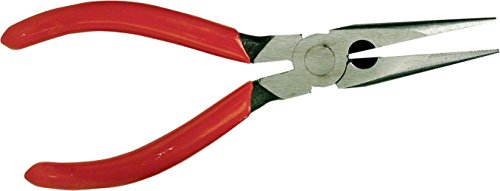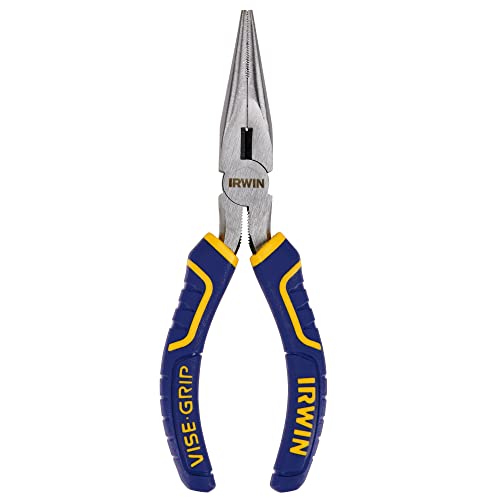The Best Needle Nose Pliers for Your DIY Projects
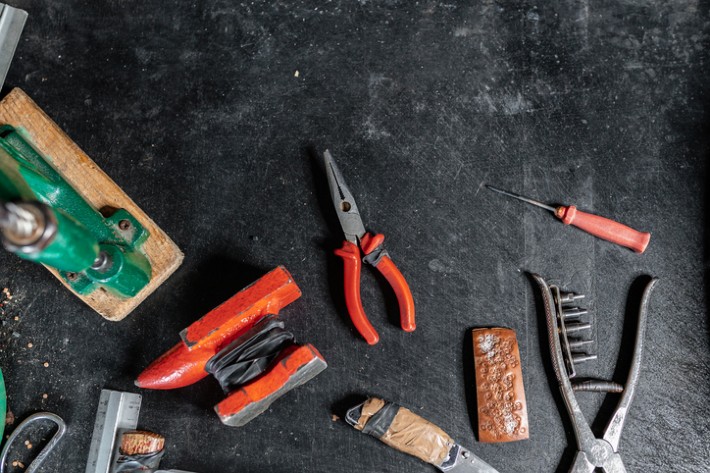
- Best Overall: Neiko Long Nose Pliers Shop Now ➔
- Runner Up: HQ Collection Needle Nose Pliers Shop Now ➔
- Honorable Mention: Viseman Needle Nose Pliers Shop Now ➔
- Contender: Sea Striker Pliers Shop Now ➔
- Also Consider: IRWIN Vise Grip Pliers Shop Now ➔
Best Needle Nose Pliers Worth Considering for 2024
Best Overall
Two 11-inch long needle nose pliers are included in this set of four pliers for normal gripping needs. It also includes bent needle nose pliers with 45-degree and 90-degree bends, allowing you to grasp things in difficult situations.
They also have non-slip grips that are comfy. This set of pliers is a decent deal at this cost, which is even better with a set of slicing jaws on one of the regular pliers, granting it more versatility than two equal straight needle nose pliers.
Pros
- A sturdy plier set with high carbon steel structure and toughened teeth
- Tapered tip pliers make it easier to reach wires and cables that are difficult to reach
Cons
- The craftsmanship is poor
Runner Up
Composed of chrome vanadium steel for task endurance and electromagnetic coating for optimum rust resistance. Rubber handles with non-slip grips give optimal comfort while in use.
Folding wires, jewelry creation, PC maintenance, electrical repairs, grabbing small objects, and so on require a tapered nose with fine points. The side cutter‘s optimum 65-degree angle enables these pliers to be strong while still being sharp, resulting in a satisfyingly smooth, clean cut with no effort.
Pros
- For fixing automobile electrical systems, this nose is exceptionally long
- This is an excellent tool for bending wires and crafting jewelry
Cons
- Edges are not accurately polished
Honorable Mention
These premium needle nose pliers have a beautiful appearance and are rust-resistant since the surface of the small pliers set has been polished and coated with anti-rust oil.
The spring construction of the craft pliers makes any task simple and quick. It can quickly help you enhance your work efficiency. Its ergonomically designed, anti-slip handle provides a secure grip. For use in winter conditions, these pliers are shielded.
Pros
- Dropped welded carbon steel with professional heat treatments
- Fine tips might reach into tight locations to aid in the completion of little undertakings
Cons
- Breaks after few uses
Contender
These Sea Striker needle nose pliers are a budget-friendly solution that will do the job. The serrated jaws hold hooks well and remain tight even when twisted forcefully. There are built-in cutters that function well with monofilament but are far from ideal. Instead of cutting the line, the cutters sometimes destroy it. These will corrode over time in a freshwater environment. They last a lot longer with a little oil. When used in saltwater, they will need to be rinsed and oiled. These are better suited for use around the house than in water-prevalent environments
Pros
- The handle has an ergonomic design, which makes it simpler to grip
- These are inexpensive and perfect for kitchen uses
Cons
- Cannot be used as a professional tool
Also Consider
This tool can be readily gripped, even when pulling, thanks to the handle grips. These pliers are great since they are built with enough precision so the jaws close parallel to each other, and the extended nose allows you to reach places that normal pliers can’t. The inside of the nose is ridged, the points are exactly aligned, and the plier is composed of a solid metal. These pliers even have Pro Touch handles with curved grips for convenience and much less hand strain.
Pros
- Optimal gripping strength
- The lengthy reach of these pliers make them appropriate for dealing in confined locations
Cons
- Jaws do not fully close
Best Needle Nose Pliers Buying Guide
Although needle-nose pliers are very widespread, they are not usually of high quality. Buying a low-quality pair can result in frustration and ruined effort. You will also have to replace them far more frequently than if you bought a high-quality set. Look for useful features, the correct sort of jaws and materials, and other considerations stated below when choosing the perfect needle-nose pliers.
What Are the Factors To Consider While Buying a Needle Nose Plier?
Length
Although length isn’t an indication of quality, it can help with convenience. Needle-nose pliers are available in a variety of lengths, ranging from 4 inches to afoot. The length of needle-nose pliers to use depends on the application. Long nose pliers may be preferred by people who work in cramped spaces such as vehicles and computer towers.
There are pliers with an 8-inch length that can reach into tight spots where their hands won’t fit. Those who store their pliers in a tool pouch or back pocket, on the other hand, would benefit from something more compact. A normal length of about 6 inches should suffice. These pliers can be used to reach into electrical boxes or loop wires.
Material
Needle-nose pliers are made of a variety of materials, and the type of material used determines the level of quality you may expect. Because you use needle-nose pliers less frequently than adjustable pliers, it may appear that you may get away with a less expensive pair.
The inverse is true, unfortunately. Because needle-nose pliers have a little surface area to grab a fastener or object, they must grip it tightly. Teeth and cross-hatching on lower-quality needle-nose pliers will deteriorate far faster than on a high-end pair.
Jaw style
Before you buy a set of needle-nose pliers, think about which jaw style will be most useful to you. A conventional set of needle-nose pliers with straight jaws would suffice for most, although certain craftsmen may prefer various kinds.
A mechanic, for example, may choose a pair of bent pliers that allow them to securely hold a fastener without limiting their line of sight. The long, narrow jaws of these pliers contain grooves for holding hooks. Because these pliers aren’t subjected to much rotating force, they may be made thinner and easily slip into a fish’s mouth or gills.
Handle
Selecting pliers with cushioned grips or non-slip handles may be the best option. To create a non-slip and padded handle, producers coat or employ over-molded grips. These grips make it possible to operate a set of pliers in a variety of situations without causing pain or discomfort.
When you’re chopping wire all day, a padded grip comes in handy. While copper is relatively easy to cut, obstinate steel wire, such as that used for fences, can be difficult. For such kinds of jobs, cushioned grips are a must.
Cost
Whenever it comes to basic tools, the cost is a subjective term. What a tradesperson considers “reasonable” may appear exorbitant to a homeowner. Nevertheless, most high-quality tools need a financial commitment. Even so, there are lots of affordable, well-made pliers in the center of the price range. There are a few good models on the cheap end as well—you just have to find what you are looking for.
What Are the Features To Look For in a Needle Nose Plier?
Durability
The material used to make the pliers has the greatest impact on their durability. As you may expect, more durable materials are more expensive.
Springs
These pliers might be challenging to open on their own. Springs are frequently installed to help them open more easily. However, some people despise springs. It is possible to find pliers without springs, albeit it is more difficult than finding ones with springs.
Nose length
The nose’s length is likewise varied. Some are only 8 inches long, while others are 12 inches long. If you’re only going to use these pliers to pick up little objects, a short length might be enough.
Those who work in confined spaces, on the other hand, may require pliers with a longer nose to reach tough wires. The nose length is frequently specified in the product description, making it simple to locate while buying.
What Is the Purpose of Needle Nose Pliers?
Pliers are essential instruments that are typically found in household tool boxes; needle-nose pliers are distinguished from other types of pliers by their unique qualities. They’re long and slender, with powerful gripping points that are sharp, curved, or angled. They’re made to squeeze into the tiniest, most constricted locations that would otherwise be impossible to access.
Some types come with a cutting tool at the tip, which is useful for cutting wires and doing electrical work. Needles-nose pliers are typically used to cut and bend thin wires and electrical wiring, but they also have other purposes. Where fingers and other instruments are too big or clunky, they can bend, cut, and grab. Premium needle-nose pliers are useful for getting into tight spots where normal pliers would be too cumbersome. They have a firm, solid grasp on several cables and can even pick up little screws.
Also, check the video from Caliber8 Tools & DIY for a more descriptive understanding of needle nose pliers.

What Are the Uses of the Needle Nose Pliers?
Crafting
Craft enthusiasts, believe it or not, utilize needle-nose pliers more than most service professionals. This is especially true for people who work in the jewelry industry. They are used by bead producers to hold the tiny beads as well as thread them onto wire or nylon. They can also help you tangle and trim the wires or nylon.
Needle-nose pliers are also useful for those who work in the stone setting industry. Holding necklace chains, installing clasps, grabbing stones to set them into holders, and holding parts in place while adhesives begin to work are all examples of these usages.
Outlet wiring
The majority of the tools you use are large and difficult to operate in tight spaces like light switch boxes and outlets. Needle nose pliers are ideal for getting into tiny spaces and gripping and moving wires.
Wirecutter
In many cases, you’d cut wires with a different tool. When dealing with little wires within an outlet or switch box, you’ll frequently need to take a break to retrieve another tool to cut cables.
People Also Asked
What is the best way to fix needle nose pliers?
Even the best hand tools will break from time to time. If this happens to you, rather than attempting a DIY repair, you're better off purchasing a new pair. If you make a mistake with the repair, they could become harmful.
Are needle nose pliers and long-nose pliers the same thing?
Actually, they are the same thing. Although there may have been a distinction in the past, the two names are now interchangeable.
Can needle nose pliers be used to remove wires?
Yes, they certainly can. Pinch the wire between the jaws just enough to pierce the plastic but not the wire to do this.
Article Contributors
The Woodsmith Review Team’s product reviews and in-depth guides are here to help you choose the best tools and gear to build great-looking projects confidently. Woodsmith is reader-supported: When you buy through links on our site, we may earn an affiliate commission. Large language models (like Artificial Intelligence) may have been used in the research and creation of the content.
Inquiries regarding specific articles or product testing should be sent to aimperiapt@gmail.com

